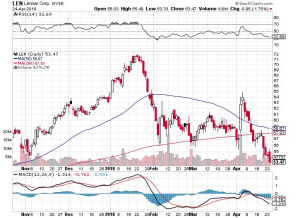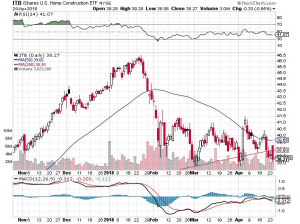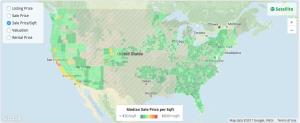It was as if someone had turned out the lights.
The homebuilders, after delivering one of the most prolific investment performance of any sector until the end of January, suddenly collapsed.
Since then, they have been dead as a door knob, flat on their backs, barely exhibiting a breath of life. While most of the market has since seen massive short covering rallies, the homebuilders have remained moribund.
The kneejerk reaction has been to blame rising interest rates. But in fact, rates have barely moved since the homebuilders peaked, the 10-year US treasury yield remaining confined to an ultra-narrow tedious 2.72%-2.95% yield.
The surprise Canadian limber import duty has definitely hurt, raising the price of a new home by an average of $3,000. But that is not enough to demolish the entire sector, especially given long lines at homebuilder model homes.
Are the homebuilders gone for good? Or are they just resting? I vote for the latter.
For years now, I have begged, pleaded, and beseeched readers to pour as much money as they can into residential real estate. Investing in your own residence has generated far and away the largest returns on investment for the past five years, and this will continue for the next 10-15 years.
For we are still in the early innings of a major real estate boom. A home you buy today could increase in value tenfold by 2030, and more if you do so on the high-growth coasts.
And while I have been preaching this view to followers for years, I have been assaulted by the slings and arrows of naysayers predicting that the next housing crash is just around the corner … only this time, it will be worse.
I have recently gained some important new firepower in my campaign. My friends at alma mater UC Berkley (Go Bears!), specifically the Fisher Center for Real Estate and Urban Economics, have just published a report written by the Rosen Consulting Group that is blowing the socks off the entire real estate world.
The implications for markets, and indeed the nation as a whole, are nothing less than mind-blowing. It’s like having a Marine detachment of 155 mm howitzers suddenly come in on your side.
The big revelation is that only a few minor tweaks and massaging of the Dodd-Frank Wall Street Reform and Consumer Protection Act of 2010 could unleash a new tidal wave of home buyers that will send house prices, and the shares of homebuilders (ITB) ballistic.
The real estate industry would at last be restored to its former glory.
That’s the happy ending. Now let’s get down to the nitty-gritty.
First, let’s review the wreckage of the 2008 housing crash.
Real estate probably suffered more than any other industry during the Great Recession.
After all, the banks received a federal bailout, and General Motors was taken over by the Feds. Remember Cash for Clunkers?
No such luck with politically unconnected realtors and homebuilders.
As a result, private homeownership in the US has cratered from 69.2% in 2006 to 63.4% in 2016, a 50-year low.
Homeownership for married couples was cut from 84.1% to 79.6%.
Among major cities, San Diego led the charge to the downside, an area where minority and immigrant participation in the market is particularly high, with homeownership shrinking from 65.7% to a lowly 51.8%.
Home price declines were worse in the major subprime cities of Las Vegas, Phoenix, and Miami.
There were a staggering 9.4 million foreclosures during 2007-2014, with adjustable rate loans accounting for two-thirds of the total.
Some 8.7 million jobs were lost from 2007-2010, while the unemployment rate soared from 5.0% to 10%. The collapse in disposable income that followed made a rapid recovery in home prices impossible.
As a result, real estate’s contribution to US GDP growth fell from 17.9% of the total to only 15.6% in 2016.
That is a big hit for the economy and is a major reason why growth has remained stuck in recent years at a 2% annual rate.
While the ruins were still smoking, Congress passed Dodd-Frank in 2010. The bill succeeded in preventing any more large banks from going under, with massive recapitalization requirements.
As a result, US banks are now the strongest in the world (and also a great BUY at these levels).
But it also clipped the banks’ wings with stringent new lending restrictions.
I recently refinanced my homes to lock in 3% interest rates for the long term, since inflation is returning, and I can’t tell you what a nightmare it was.
I had to pay a year’s worth of home insurance and county property taxes in advance, which were then kept in an impound account.
I was forced to supply two years worth of bank statements for five different accounts.
Handing over two years worth of federal tax returns wasn’t good enough.
To prevent borrowers from ginning up their own on TurboTax, a common tactic for marginal borrowers before the last crash, they must be independently verified with a full IRS transcript.
Guess what? A budget constrained IRS is remarkably slow and inefficient at performing this task. Three attempts are common, while your loan sits in limbo.
(And don’t even think of asking for Donald Trump’s return when you do this. They have NO sense of humor at the IRS!)
Heaven help you if you have a FICO score under 700.
I had to hand over a dozen letters of explanation dealing with assorted anomalies in my finances. My life is complicated.
Their chief goal seemed to be to absolve the lender from any liability whatsoever.
And here’s the real killer.
From 2014, banks were forced to require from borrowers a 43% debt service to income ratio. In other words, your monthly interest payment, property taxes, and real estate taxes can’t exceed 43% of your monthly gross income.
This hurdle alone has been the death of a thousand loans.
It is no surprise then that the outstanding balance of home mortgages has seen its sharpest drop in history, from $11.3 trillion to $9.8 trillion during 2008-2014. It is down by a third since the 2007 peak.
Loans that DO get done have seen their average FICO scores jump from 707 to 760.
Rocketing home prices are making matters worse by reducing affordability.
Only 56% of the population can now qualify to buy the mean American home priced at $224,000, which is up 7.7% YOY.
Residential fixed investment is now 32% lower than the 2005 peak.
Also weighing on the market was a student loan balance that rocketed by 400% to $1.3 trillion since 2003. This eliminated a principal source of first-time buyers from the market, a major source of new capital at the low end.
Now for the good news.
Keep Dodd-Frank’s capital requirements, but ease up on the lending standards only slightly, and all of the trends that have been a drag on the market quickly reverse.
And yes, some 2.3% in missing US GDP comes back in a hurry, and then some. That’s a whole year’s worth of economic growth at current rates.
Rising incomes generated by a full employment economy increase loan approvals.
Foreclosure rates will fall.
More capital will pour into homebuilding, alleviating severely constrained supply.
More investment in homes as inflation hedges steps up from here.
The entry of millennials into the market in a serious way for the first time further increases demand.
Promised individual tax cuts will add a turbocharger to this market.
There is one way the Trump administration could demolish this housing renaissance.
If the deductibility of home mortgage interest from taxable income on Form 1040 Schedule “A” is cut back or eliminated to pay for tax cuts for the wealthy, a proposal now being actively discussed in the White House, the whole party is canceled.
The average American will lose his biggest tax break, and the impact on housing will be huge.
A continued war on immigrants will also hurt, as they accounted for one-third of all new households from 1994-2015.
You see, we let them in for a good reason.
Assuming this policy self-inflicted wound doesn’t happen, the entire homebuilding sector is a screaming “BUY.”
On the menu are Toll Brothers (TOL), DH Horton (DHI), and Pulte Homes (PHM).
You can also add the IShares US Home Construction ETF (ITB), a basket of the leading homebuilding names (click here for the prospectus at https://www.ishares.com/us/products/239512/ishares-us-home-construction-etf ).
To read the UC Berkeley report in its entirety, entitled Homeownership in Crisis: Where Are We Now?, a must for any serious real estate professional or investor, please download the PDF file for free by clicking here at http://escholarship.org/uc/item/31q9h8m0?query=homeownership%20in%20crisis
The bottom line here is that after a three-month break the stirrings of a recovery in homebuilders may be just beginning.






Where It’s Hot

It’s Always Better on the Coasts



